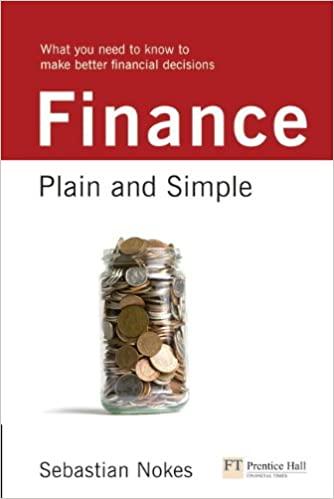Question
Mini-case Student Name: Ms. Katherine Tibbs is director of the EastMutual's fixed-income security management division. The HR department of EastMutual has asked Ms. Katherine Tibbs
Mini-case
Student Name:
Ms. Katherine Tibbs is director of the EastMutual's fixed-income security management division. The HR department of EastMutual has asked Ms. Katherine Tibbs present an investment seminar to new employees of this year. As a financial analyst in the division, you have been asked to prepare answers to the following issues that will be discussed in the investment seminar.
=====================================================================
[1] What are the meanings of the key characteristics of a bond (e.g., par value, coupon rate, year to maturity, issue date, and default risk)?
The following terms and definitions are those associated with the key characteristics of a bond:
Par Value (Face value or Principal Value) the payment at the maturity date of the bond
Coupon Rate this is the annual interest rate as percentage of par value for the coupon
Yield to Maturity this is the total return anticipated on a bond if the bond is held until it matures
Issue Date the date on which a security, in this case bond, is issued
Default Risk is the chance that the bond issuer will not make the required coupon payments or principal repayment to its bondholders.
=====================================================================
[2-a] How is the value of a bond determined? What is the value of a 10-year, $1,000 par value corporate bond with a 10 percent annual coupon if its required rate of return is 10 percent?
[2-b] What would be the value of the 10-year, $1,000 par value corporate bond with a 10 percent annual coupon (as described in part 2-a), if its required rate of return is 13 percent? Would we now have a discount or a premium bond?
The value of the 10 year bond at a returned rate of 13% would be $248.04
[2-c] What would be the value of the 10-year, $1,000 par value corporate bond with a 10 percent annual coupon (as described in part 2-a), if its required rate of return is 7 percent? Would we now have a discount or a premium bond?
[2-d] What would happen to the value of the 10year bond over time if the required rate of return remained at 13 percent, or if it remained at 7 percent?
(Hint: with a financial calculator, enter PMT, I/YR, FV, and N, and then change (override) n to see what happens to the PV as the bond approaches maturity.)
Please compute bond prices of these 3 bonds (in 2-a, 2-b, and 2-c) in year 0, year 2, year 4, year 6, year 8 and year 10 (maturity date) and provide your answers in the following table;
Please plot the prices on a diagram. In this diagram, the x-axis denotes years (such as year 0, year 2, year 4, year 6, year 8 and year 10) and y-axis denote bond prices.
| Bond Price =? | Bond Price =? | Bond Price =? | Bond Price =? | Bond Price =? | Bond Price =? | |
| Year 0 | Year 2 | Year 4 | Year 6 | Year 8 | Year 10
| |
| The 10% 10-year bond with YTM 7% | ||||||
| The 10% 10-year bond with YTM 10% | ||||||
| The 10% 10-year bond with YTM 13% |
=====================================================================
[3-a] What is the yield to maturity on a 10-year, 9 percent annual coupon, $1,000 par value bond that sells for $887.00? That sells for $1,134.20? What does the fact that a bond sells at a discount or at a premium tells you about the relationship between rd and the bond's coupon rate?
[3-b] What is the current yield for the 10-year, 9 percent annual coupon, $1,000 par value bond that sells for $887.00? What are the current yield for the 10-year, 9 percent annual coupon, $1,000 par value bond that sells for $1,134.20? (Assume the bond is held to maturity and the company does not default on the bond.)
=====================================================================
[4] How does the equation for valuing a bond change if semiannual payments are made? That is, if a $1000 face-value bond has 10% coupon rate, then this bond pays 2 coupon payments in each year and each coupon payment is $50 (= 10%*$1000/2).
(i) Find the value of a 10-year, semiannual payment, 10 percent coupon bond if nominal rd = 10%.
(ii) Find the value of a 10-year, semiannual payment, 10 percent coupon bond if nominal rd = 13%.
(iii) Find the value of a 10-year, semiannual payment, 10 percent coupon bond if nominal rd = 7%.
Step by Step Solution
There are 3 Steps involved in it
Step: 1

Get Instant Access to Expert-Tailored Solutions
See step-by-step solutions with expert insights and AI powered tools for academic success
Step: 2

Step: 3

Ace Your Homework with AI
Get the answers you need in no time with our AI-driven, step-by-step assistance
Get Started


